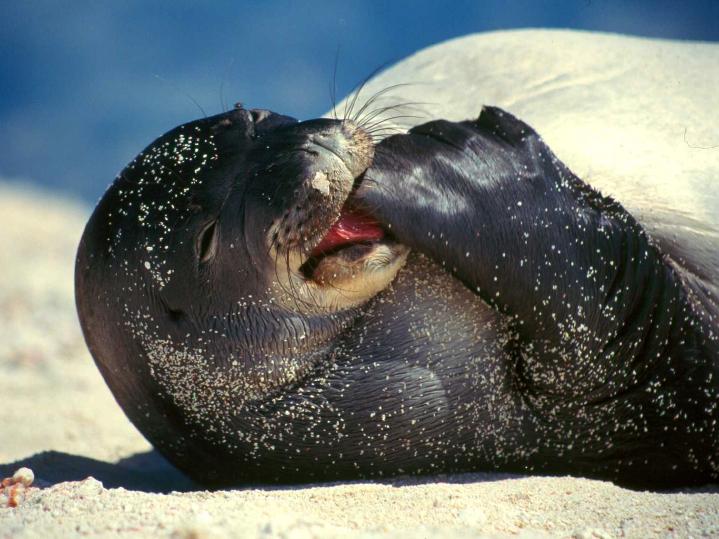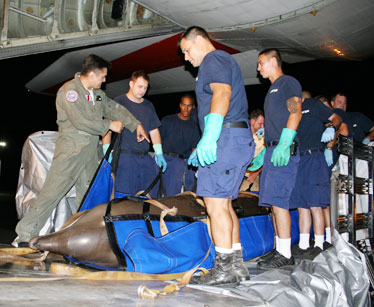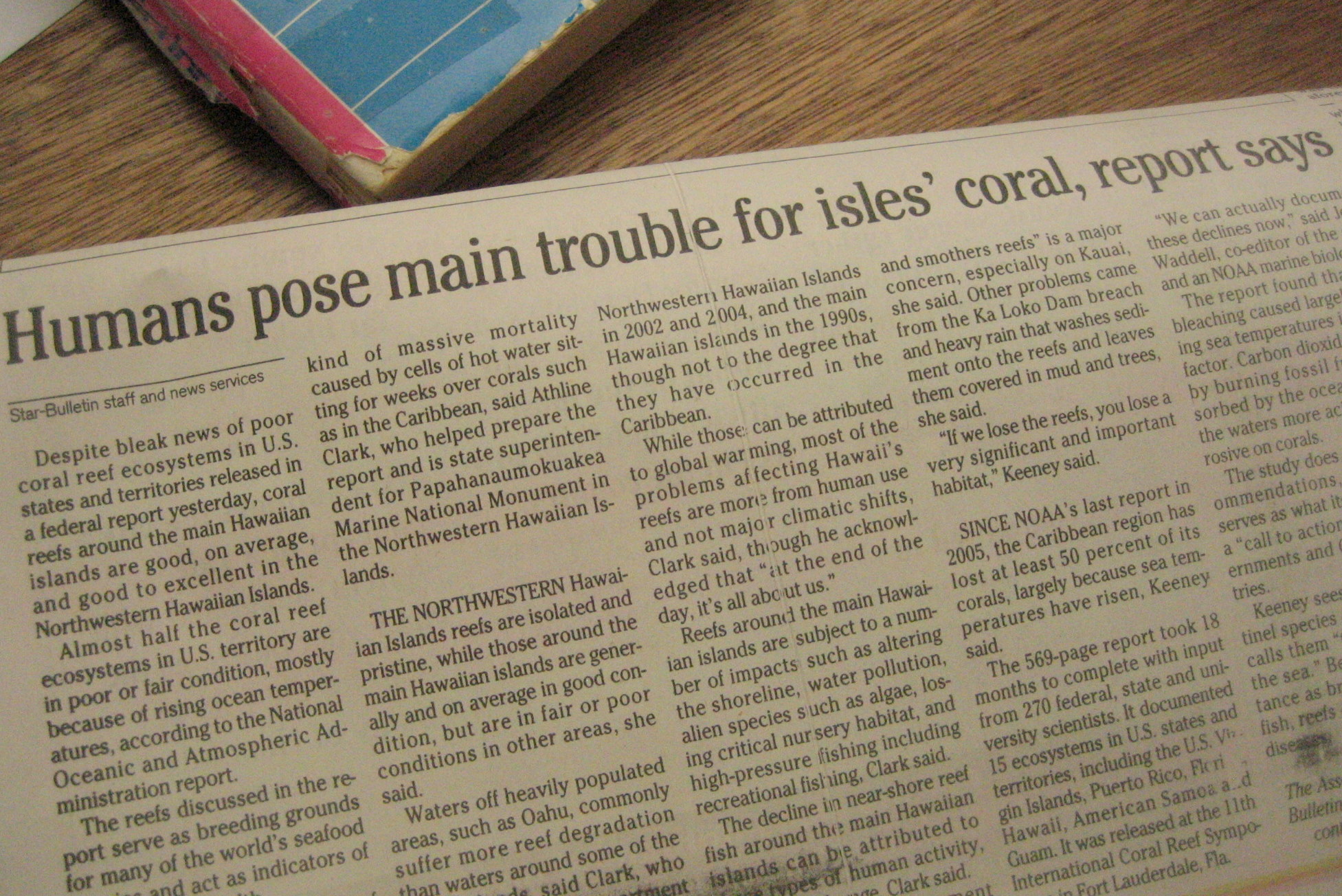Blog
News, updates, finds, stories, and tidbits from staff and community members at KAHEA. Got something to share? Email us at: kahea-alliance@hawaii.rr.com.
- no limit on military activities affecting Monument resources (not even a discussion of what it would take to abide by the proclamation and “minimize and mitigate” half-pound pieces of fiery shrapnel hitting Nihoa).
- no ban on bioprospecting, which is the taking of public trust resources for exploitation and profit by corporations, academic institutions, and private individuals.
- no limit on the number of people that can access and/or take from this “no take” reserve.
- no assessment of the cumulative risks and impacts of past and anticipated human activity in the Monument.
- no public advisory council, which has been key in forcing transparent & accountable decisionmaking.
Are they hoping nobody would notice?
From Marti:
Late in the day on December 23rd, the final version of the Monument management plan was quietly published on the Papahānaumokuākea website. No press release. No email to the list serv. Just a quick post on the eve of the Eve of Christmas, which just happened to get picked up in a google alert days later.
Given all the eco-mojo the Bush Administration has tried to squish out of this “blue asterisk,” you would expect a mighty deal be made of finally finishing the management plan two years later. The fact that the release was so secretive has gotta make you wonder what’s actually in it.
On their website, James Connaugton, chairman of the White House Council on Environmental Quality is quoted as saying:
“When President Bush first designated the Papahānaumokuākea Marine National Monument in June 2006, his goal was to move beyond just thinking about conservation to carefully managing this important area.”
Yikes! What does the federal government mean exactly when it says “move beyond” conservation?
Well, from what we see in the plan it means:
Over 50% of the proposed 355 million-dollar budget is for government operations and research, while a mere 12% goes to reducing existing threats, like clean-up of marine debris and legacy military contamination. The plan also fails to allocate sufficient resources for Native Hawaiian involvement in Monument decision-making, and leaves decision-making to a closed-door Monument Management Board.
The plan essentially abandons the “precautionary principle,” which was a hallmark of the State’s visionary pre-monument protections that required biological, cultural and historic resource integrity be favored when the impacts of any proposed activity were uncertain.
So while the revised vision, mission, and goals now commit to conservation as the purpose of the Monument, you can see that the actions to implement this plan remain largely unimproved over the weak draft released earlier this Spring.
When the draft version of this plan was released, the National Wildlife Federation, the Center for Biological Diversity and more than a dozen other organizations–representing well over 5 million people–joined KAHEA in strongly criticizing the management plan. Despite two years of advocacy, and thousands of public letters and comments calling for a stronger, more protective plan, it is apparent that our united call for a true pu‘uhonua didn’t fit with the federal government’s vision for the future of “conservation” in the Northwestern Hawaiian Islands.
So, here’s our take – a quote for the papers – on the federal government’s attempt to “move beyond” conservation:
“This is conservation on paper, but not in practice. They have reshuffled the goals to say ‘full conservation’ but their proposed actions speak louder than their words. They are exempting increased military exercises proposed for this extremely delicate ocean habitat from management. They are proposing increased tourism, new construction, and extractive research without adequate public oversight and Native Hawaiian consultation,” said Marti Townsend, Program Director of KAHEA: The Hawaiian-Environmental Alliance.
To learn more about this issue, including a detailed review of the draft plan, visit our website at: www.kahea.org
State Auditor Criticizes Superferry Exemption
Front page news: “Allowing ship to sail without EIS sets risky precedent, auditor says.” Nice to have it affirmed, but isn’t that what we all knew LAST year? Sigh.
http://www.honoluluadvertiser.com/article/20081218/NEWS09/812180367
Lubchenco to head NOAA
From todayʻs Washington Post, looks like Oregon Professor will be tapped to head up the National Ocean and Atospheric Administration. NOAA is one of three co-trustees (the other two are the Department of Interior and the State of Hawaii) entrusted with conservation of the Northwestern Hawaiian Islands.
http://voices.washingtonpost.com/the-trail/2008/12/18/lubchenco_will_helm_national_o.html
Feds Will Consider More Critical Habitat for Monk Seal
On Friday, in response to a petition from KAHEA, the Center for Biological Diversity, and the Ocean Conservancy, the National Oceanic and Atmospheric Administration (NOAA) announced it will consider designating additional critical habitat for the highly endangered Hawaiian monk seal in the Northwestern as well as Main Hawaiian Islands. This is an important first step! Hawaiian monk seals are today one of the most endangered marine mammals in the world.
The petition seeks to have beaches and surrounding waters throughout Hawai’i protected as critical habitat for Hawaiian monk seals under the Endangered Species Act.
What will more critical habitat for monk seals do? More critical habitat will require the federal government to limit federal activities that could harm the beaches and nearshore waters used by monk seals. It will prevent the federal government from permitting a private development or constructing a federal highway that might harm protected critical habitat. It would also give the State access to federal funds to support state efforts to encourage monk seal recovery.
What does it NOT do? This would not in any way limit public access to beaches or give the federal government any new control over our beaches or add any new restrictions on fishing.
Why do we need more critical habitat?The monk seal currently has critical habitat designated only in areas of the Northwestern Hawaiian Islands, where monk seals are dying of starvation and populations of monk seals are plummeting. Seal pups have only about a one-in-five chance of surviving to adulthood. Other threats include becoming entangled and drowning in abandoned fishing gear, shark predation, and disease.
At the same time, the main islands are becoming increasingly important habitat for the monk seals. Monk seals in the main Hawaiian Islands are thriving and giving birth to healthy pups. Hawaiian monk seals are present on each of the main islands, and their numbers are steadily increasing.
“This government finding that it will consider designating critical habitat for monk seals in the main Hawaiian Islands marks an important step toward preventing the extinction of the Hawaiian monk seal,” said Miyoko Sakashita, a staff attorney with the Center for Biological Diversity and author of the petition. “Habitat in the main Hawaiian Islands is essential for the survival of the imperiled monk seals.”
Habitat in the main islands will also provide a refuge for monk seals as sea-level rise floods the low-lying Northwestern Hawaiian Islands. Global warming is an overarching threat to the Hawaiian monk seal and its habitat. Already, important beaches where seal pups are born and raised have been lost due to sea-level rise and erosion.
“We have already seen the extinction of the Caribbean monk seal–a relative of the Hawaiian monk seal. The threat is real and we must act now,” said Vicki Cornish, vice president of marine wildlife conservation at Ocean Conservancy. “We are greatly encouraged by this consideration to extend critical habitat designation in the main Hawaiian Islands. It is a necessary step in making sure Hawaiian monk seals do not suffer the same fate as their relatives.”
Critical habitat designation will mean greater protection of Hawaiian monk seal habitat under the Endangered Species Act. Once designated, any federal activities that may affect the critical habitat must undergo review to ensure that those activities do not harm the Hawaiian monk seal or its habitat.
In passing the Endangered Species Act, Congress emphasized the importance of critical habitat, stating that “the ultimate effectiveness of the Endangered Species Act will depend on the designation of critical habitat.” Recent studies have shown that species with critical habitat are twice as likely to recover as species without it.
“What happens in the coming few years will determine the survival of this species,” according to Marti Townsend, Program Director of KAHEA: The Hawaiian-Environmental Alliance. “We cannot afford the extinction of a creature so sacred in Hawaiian culture and endemic to these islands. And we cannot expect to save this species without engaging in the hard task of meaningfully protecting habitat.”
more info at www.kahea.org.
Coincidence, totally. Right.
Monday = RIMPAC exercises end and another whale strands itself on Molokai beach. Think they’re related?
“Any statements implicating sonar or RIMPAC activities are premature and speculative,” said spokesman Mark Matsunaga.
Star-Bulletin story: http://starbulletin.com/2008/07/30/news/story09.html
“Obviously I feel that there may be a correlation because, for one thing, this type of whale stranding does occur for a variety reasons. This particular type of whale has consistently been associated with stranding related to the Navy’s sonar all around the world,” said Paul Achitoff, attorney with the Earthjustice office in Hawaii, adding, “So when one happens while the Navy is using its sonar … it’s obviously something that should raise concern among any objective person.”
but we knew that already
Star-Bulletin headline from yesterday: “Humans pose main trouble for isles’ coral, report says.” So says the report-back from the 11th International Coral Reef Symposium.
The good news is that on average Hawaiian reefs are doing better than those in other places under United States jurisdiction, despite pressures from human impacts. According to the report, the Northwestern Hawaiian Islands–an area whose remoteness has protected it from many types of human impacts–are still considered relatively pristine.
Full story here: http://starbulletin.com/2008/07/08/news/story03.html
Honolulu NWHI Hearing Online
Video of the Honolulu hearing on the Draft Management Plan for the Papahanaumokuakea Marine Monument in the Northwestern Hawaiian Islands held in Honolulu on June 24th. The 1,200 page plan will direct the future of public trust resources in the last, large intact Hawaiian reef ecosystem in the world.
At the hearing, leading local conservation voices, including Keiko Bonk, Marjorie Ziegler, Dr. Stephanie Fried, Kyle Kajihiro, Leila Hubbard, Dave Raney, Don May and KAHEA staff (Evan, Bryna, Marti, and Miwa) testified to their concerns about the draft plan. (Testimony starts at 33:30).
In the largest no-take marine reserve on the planet, this draft of the Federal/State plan is proposing: the construction of a “small municipality” on Midway, new cruise ships, more tourists, increases in extractive research, new risks of invasive species introductions, exemptions for fishing, and opening of the area to bioprospecting. An expansion of military activities–including sonar, ballistic missile interceptions, and chemical warfare simulations–would be allowed to go forward with no mitigations. The plan also disbands the existing citizen advisory council, which is pretty much the only opportunity for members of the public (non-government scientists, advocates, cultural practitioners, and resource experts) to participate in decision-making.
You can also watch the hearings on `Olelo Channel 52.
You can support by submitting your own written comments, signing our petition, and spreading the word. Mahalo piha to the thousands who have already supported the call for a better plan!








